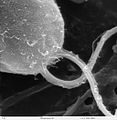
Think keeping algae growth of invasive species under control is easy? Think again.
Picture this; You've spent the time, and money in the lab, experimenting to find your perfect strain and the perfect nutrients for algae growth. You've spent countless hours in research, laboring over your various co products. You've tested, tweaked, and retested to exactly the right conditions for your climate, and it's all paid off.
You've built your mini ponds, then graduated to test ponds. You've moved step by step, from lab scale, to proof of concept, up to pilot scale. Meanwhile, the sun continues to shine, your ponds are getting greener, your alga is getting fat and dripping with lipids. Those carbon credits are starting to stack up. You're starting to buff up on your interview with Oprah and the New York Times is calling.

Right when you think things couldn't get any better, a two celled micro organism called Phagocytosis decides to visit.
Then decides to take up residence.
Then decides to take over.
Worse, that pesky little parasite starts kicking ass! Your ponds start to wither, turning brownish. You start to see it all flash before your eyes. First, it robs you of algae growth, then goes after your dignity, after which it sets your profits firmly within it's cross hairs.
If you're sitting on the sidelines of the algae revolution this might sound like a cautionary tale.
If you're in the trenches, you can recognize it for what it is…warfare.
Microbiologic warfare. And trust me, it most definitely is survival of the fittest. The problem is, in all our coddling them to get algae to grow, we also rob them of the ability to fend for themselves in the wild. Generally, algae survive by safety in numbers. They are able to reproduce quickly enough to overtake their natural predators and (hopefully) consume them too.
Invasive species have finally received some attention.

That’s why is what so interesting yesterday when Sapphire Energy announced the completion of a collaborative study which identified the morphology, ultrastructure, and life history of A. protococcarum, one of the most difficult to manage algae parasites.
Their findings are detailed in “Characterization of Amoeboaphelidium Protococcarum: An Algal Parasite New to the Cryptomycota Isolated from an Outdoor Algal Pond Used for the Production of Biofuel,” published today in the online scientific journal PLOS ONE — you can read it above. “Identifying and overcoming crop protection challenges, from pest control to environmental factors, is critical to ensuring successful, scalable algae farming, and has long been a part of the research and development objective of Sapphire Energy,” said Alex Aravanis, MD, Ph.D., chief science officer at Sapphire Energy.
What Word of Wisdom from Sapphire and friends?

Good news — In the short run, not much. In the long run it means attention is finally being paid to this aspect of algae growth in open pond production, not just birthing and fattening them.
Bad news — it definitely looks like there is a gap as wide as the Grand Canyon in terms of the effort that will be needed to catalog all known parasites and design defenses (not to mention competitors, predators and the like).
Meaning there’s still a lot of faith in the algae business — the faith, that is, that overcoming the challenges is feasible both in economics and in time.
For the skeptics (of course) will continue to shout, “where are the gallons?” and the answer cannot be some lowbrow algae predator ate them all up, or they were slayed by a virus.
What does it all mean to us?
It means, we need to stick with the tried and true methods of containing invasive species with constant inculcation and covered ponds, and with poly cultures. It also means synthetic cures are on the horizon. That soon, we'll see "Round-Up" for algae ponds on the store shelves.
It also means big business is getting into the act. Algae biorefineries aren't going away.
You can get all the details about building and maintaining open ponds on the only book ever written on the subject. "Building Open Ponds" available by clicking on the graphic below.
You Might Also Be Interested In...

Keeping Ponds Free of Invasive Species
Right when you think it couldn't get any better, a two-celled organism decides to take up residence in your pond. Read More

Algae Yields in Open Ponds
Nowhere in the world of algae cultivation is the disagreement as intense as it is when it comes to algae yields in open ponds. Read More

Open Pond Biofuels
Algae Cultivation in Open Ponds: is still the only way to mass produce algae products, however it's not without it's challenges. Read More
The Algae Revolution Has Begun
...easy reading, to the point, well organized
Hello David. I trust you are well. Your project is definately a labor of love. I have spent about 3+ hrs reading. looks like an 8 hr read to get all the details. I would again thank you for your work, easy reading, to the point, well organized.



